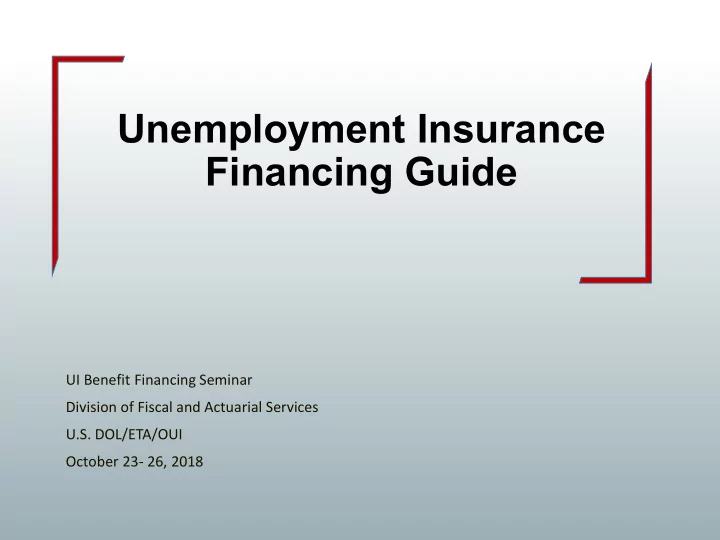

Unemployment Insurance Financing Guide UI Benefit Financing Seminar Division of Fiscal and Actuarial Services U.S. DOL/ETA/OUI October 23- 26, 2018
Unemployment Insurance Financing Technical Guide Guidelines for the Construction and Analysis of State Unemployment Insurance Financing Structures With Accompanying Spreadsheet Assistance Tool U.S. Department of Labor Office of Unemployment Insurance Division of Fiscal and Actuarial Services
Un Unem employment I t Insurance F ce Financi cing Technical al G Guide • How to Build an Unemployment Insurance Tax Structure • Tax Structure Troubleshooting Guide
How to Build an Unemployment Insurance Tax Structure Step 1. Calculate a Base Level of Financing Step 2: Make the Base Financing Rate Effective When an Adequate Fund Balance Has Been Reached Step 3. Adjust the Level of Tax Rates Based on Trust Fund Solvency Step 4. Assign Tax Rates to Individual Employers
Accompanying Spreadsheet Model to Construct a Tax Table DFAS Tax Structure Model Step 1 Base Financing Rate Calculator This calculator derives the long- run average benefit cost in a state which is then used as the starting Base Financing Rate for building a UI tax structure. INPUTS: STATE: Year Of Base Financing Rate Calculation: Number of Years of Benefits to Use for Calculation: Taxable/Total Wage Ratio Option (1=Current Ratio, 2=User-estimated Ratio): 2 User-estimated Ratio: 0.391 Base Financing Rate: 0.88% of Total Wages for 2016 2.25% of Taxable Wages for 2016
Accompanying Spreadsheet Model to Construct a Tax Table CA For State: INPUTS: Below Above Base Base Base Input Desired Tax Schedule Parameters Schedule Schedule Schedule Base Financing Rate (% of Taxable Wages): 2.25% Base Schedule Trigger Range (AHCM, High-Low): 1.30 to 0.80 Desired Number of Tax Schedules: 1 7 Triggers for Lowest/Highest Financing Rates (AHCM): 1.50 0.25 WARNING Methodology Used to Calculate Tax Schedule Parameters Select Calculation for Deriving Financing Rates (1- 3): 1 (1 = Set Minimum and Maximum Financing Rates) 1.20% 3.60% (2 = Set Responsiveness Rate Between Schedules) 60% 51% (3 = Set Fixed Gap Closing Rate) 40% 51%
Troubleshooting ng G Guide • Issue 1) Tax Rates are Too Low • Issue 2) Low Fixed Taxable Wage Base • Issue 3) Ineffective Charges Are Too High and Not Recouped • Issue 4) Inadequate Tax Rate Adjustments for Changes in Trust Fund Solvency • Issue 5) Unresponsive Solvency Triggers • Implementing Alternative Measures of Experience Rating
South Carolina Benefits, Taxes, Trust Fund Reserves (1975-2009) (% of Total Wages) 2.0 6.0 Reserve Ratio Ben Ratio Tax Ratio 5.0 1.5 4.0 1.0 % of Total Wages 3.0 0.5 2.0 0.0 75 76 77 78 79 80 81 82 83 84 85 86 87 88 89 90 91 92 93 94 95 96 97 98 99 00 01 02 03 04 05 06 07 08 1.0 -0.5 0.0 -1.0 -1.0 Year
South Carolina Benefits, Taxes, and Trust Fund Reserves (2009-2017) (% of Total Wages) Reserve Ratio Ben Ratio Tax ratio 2 6.00 1.5 5.00 1 4.00 0.5 % of Total Wages 3.00 0 09 10 11 12 13 14 15 16 17 2.00 -0.5 1.00 -1 0.00 -1.5 -2 -1.00 Year
California Benefits, Taxes, Trust Fund Reserves (1975-2017) (% of Total Wages) 6 2 Reserve Ratio Benefit Ratio Tax Ratio 5 1.5 4 1 3 % of Total Wages 2 0.5 1 0 0 1975 1977 1979 1981 1983 1985 1987 1989 1991 1993 1995 1997 1999 2001 2003 2005 2007 2009 2011 2013 2015 2017 -0.5 -1 -2 -1
Exer ercise se Build Your S State B Benefit, C Contributions, a and T Trust F Fund Res eser erve T e Time-Ser eries g s graph • Using Data from the 394 Handbook : https://workforcesecurity.doleta.gov/unemploy/hb394.asp • Select the “Taxable Significant Measures” category • Select the State and the Year • Select all of the Data and Copy into Excel Spreadsheet • Use the “Benefits Paid’, “Avg. Employer Tax Rate” and “Reserve Ratio” to create a graph ( select combo graph)
Recommend
More recommend